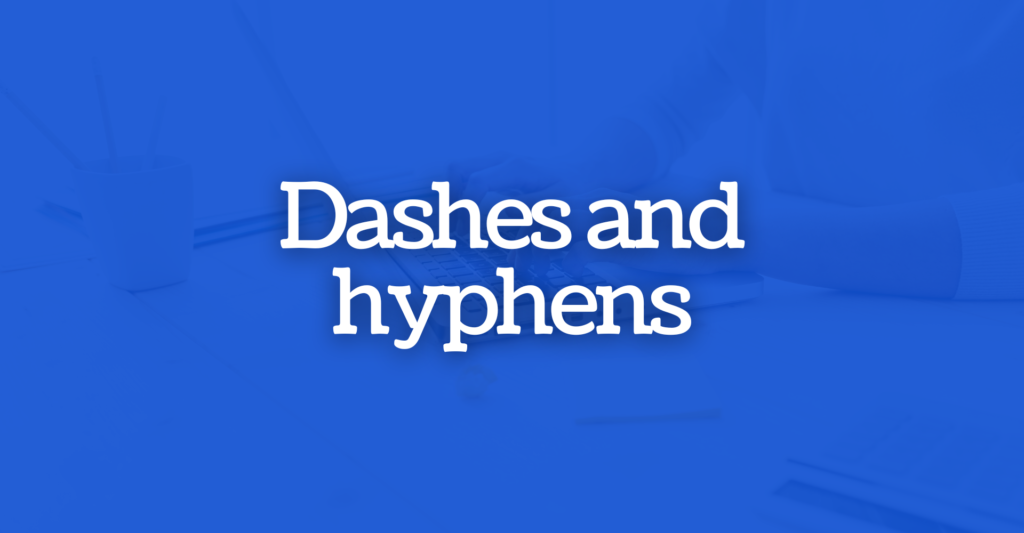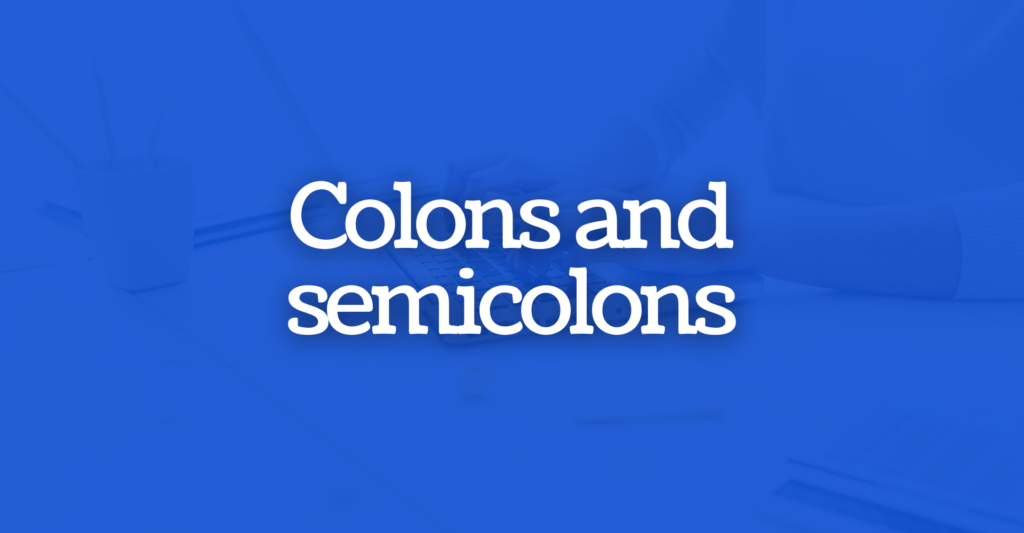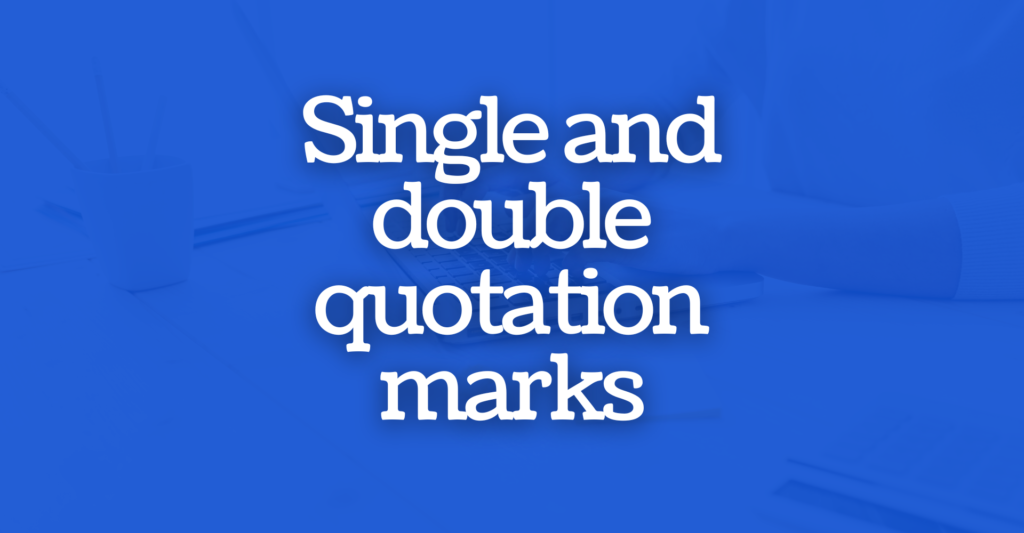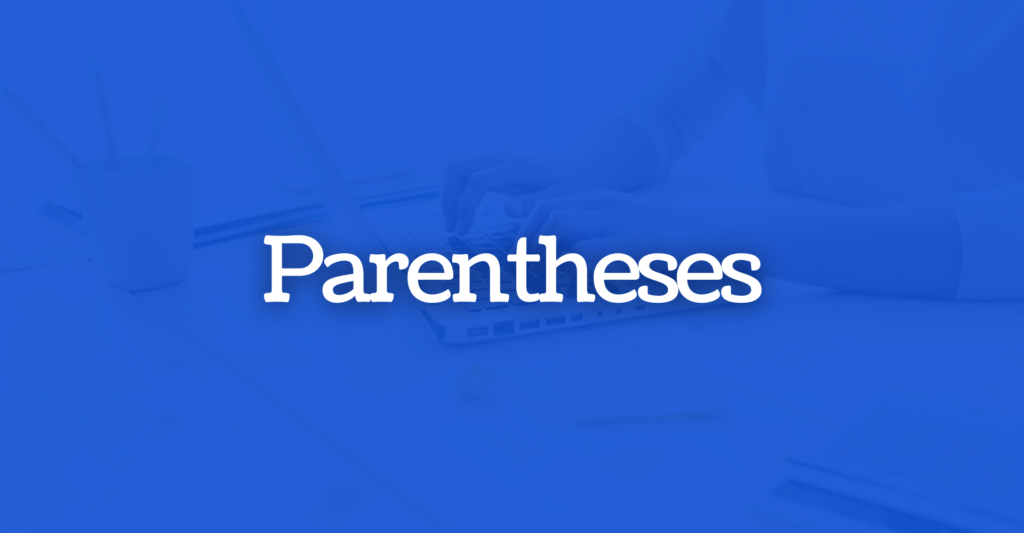Have you heard fellow writers confess their love for em dashes or Oxford commas and wondered — why all the hype? Why do writers adore certain punctuation marks so much they even make t-shirts for them? Eh hem…guilty.
I think it comes down to the fact that punctuation can expand your ability to effectively communicate. Commas and periods only go so far. When you want to pause for dramatic effect, explain complex ideas, or add quotes in quotes — you need more.
To help, here’s a guide to several types of punctuation that can get a bit confusing. Learn what each punctuation mark is, how to type it (some are tricky), and when to use it.
Want to jump ahead?
- Hyphens
- En dashes
- Em dashes
- Triple em dashes
- Colons
- Semicolons
- Double quotation marks
- Single quotation marks
- Ellipses
- Oxford commas
- Parentheses
- Brackets
- Braces
Dashes and hyphens

Dashes may seem pretty simple and straightforward. But did you know there are three main types — the en dash, em dash, and triple-em dash? Here, we’ll cover all three (plus the hyphen which can be easily confused with a dash).
- hyphen (-)
- en dash (–)
- em dash (—)
- triple em dash (— — —)
Hyphens
The hyphen (-) is not technically a dash, but it looks like a short one.
How to type a hyphen
Hyphens are easy to type as they have a dedicated key on U.S. keyboards that’s shared with the underscore.
When to use hyphens
Hyphens should be used when:
- A word has more than one syllable and is divided between two lines.
- You want to spell out a word letter by letter in your writing (g-o-o-d-b-y-e).
- You need to join two or more words to form compound adjectives before a noun (kind-hearted person).
- Two vowels make a word awkward (pre-elect).
- A lack of a hyphen would cause the word to be misread (re-creation).
- You write compound numbers (thirty-two).
- You want the text to be read as a stutter (I’m s-s-s-sorry).
- You use certain prefixes like all- and self- (self-sufficient).
- You use certain suffixes like -elect (president-elect).
En dashes
The en dash (–) is a dash that’s the length of the letter “n.”
How to type an en dash
You can type an en dash on a Mac by pressing the “option” key and the hyphen key at the same time. On Windows, press the “Alt” key, type 0150, and release the “Alt” key.
When to use en dashes
En dashes are used to replace the words “to” and “through” in ranges of numbers, spans of time, and scores. For example:
- I read chapters 1–3 of my book.
- The seasonal resort is open April–October.
- The Eagles are winning 21–19.
They’re also used if you’re writing a compound adjective and a hyphen doesn’t work. This often happens when the compound adjective is a proper noun. Here’s an example:
- She’s a Pulitzer Prize–winning journalist.
You wouldn’t put a hyphen between Pulitzer and Prize so you add the en dash which tells the reader the two preceding words are part of the compound adjective.
Em dashes
Now, for the favorite of many writers — the em dash. Em dashes are longer dashes that are the length of the letter “m.”
How to type an em dash
To type an em dash on a Mac, press “option+shift+hyphen key” at the same time. Note, some mac keyboards have an “alt” key instead of the “option” key. On a PC, press “control+alt+hyphen key.”
If you have trouble, you can always head over to Google, search for em dash, and copy and paste the mark into your document.
When to use em dashes
Em dashes are a very versatile type of punctuation that can be used to replace other marks including parentheses or commas. They work well when you want to set information apart, mark an abrupt turn in a sentence, or expand on something without creating a run-on sentence.
Here are some examples:
- My favorite dress — which had beautiful floral appliques all over it — was destroyed in the wash.
- I love to cook — I’m always trying new recipes.
- We went to the lake and had a great day but — never mind, I don’t want to talk about it.
3-em dashes
The 3-em dash is created by typing the em dash three times in a row with spaces between each em dash (— — —)
When to use 3 em dashes
The 3-em dash is commonly used by journalists to signal that words have been left out or names have been omitted (like names of sources who don’t want to go on the record).
It can also be used to cite works by the same author in a Chicago format paper.
Colons vs. semicolons

Now that we’ve covered dashes in-depth, let’s move on to colons and semicolons. Semicolons look a lot like colons, have similar uses, and are even located on the same computer key; it’s no wonder so many people get them confused! But, they are different so let’s take a closer look at when to use each.
Colons
A colon looks like two stacked periods (:).
How to type a colon
The colon is found to the right of the “L” on the middle row of U.S. keyboards. It’s on the same key as the semi-colon and you must press shift along with the button to get the regular colon.
When to use a colon
Colons signal to readers that important information is coming, whether that’s a list, an example, a quote, or a noun or noun phrase. Here’s an example:
- In the words of Nelson Mandela: “The greatest glory in living lies not in never falling, but in rising every time we fall.”
Writers also use colons in article titles to tack on interesting subtitles as you can see below:
Much like an em dash, a colon can be used to connect two sentences in a way that adds emphasis. The second sentence will usually explain, demonstrate, or add extra detail to the first.
- Life is like a box of chocolates: you never know what you’re going to get.
Semicolons
A semicolon looks like a period stacked on top of a comma (;).
How to type a semicolon
As mentioned above, the colon and semicolon share the same key to the right of the “L” key. To type a semicolon, simply tap that key. Easy peasy!
When to use a semicolon
Like colons, semicolons can be used to link two related sentences, but they don’t provide as much emphasis. They usually take the place of connecting words and conjunctions (e.g. and, but, or, so), as shown in the example below.
- I like ice cream; I eat it all the time.
Semicolons can also be used in conjunction with linking adverbs (e.g. however, likewise, further, also, besides).
- I would love to pursue a side hustle; however, I don’t think I have enough time.
Finally, you can use semicolons in lists to separate items that contain commas so readers don’t get confused.
- Recently I visited New Orleans, Louisiana; Mobile, Alabama; and Los Angeles, California.
Quotation marks (single and double)

If you’re thinking, “Quotation marks aren’t confusing,” hold my beer. Just kidding, but they can get a bit tricky — especially when you’re dealing with quotes inside quotes. Here’s a quick look at single and double quotation marks.
**Disclaimer: The rules on quotation marks change depending on whether you’re writing in UK or US English. In US English, the default is the double quotation marks (“quote”). In UK English, the default is single marks (‘quote’).
How to type quotation marks
Both single and double quotation marks are on the same key to the right of the colon and semicolon. The single quote is default and the double requires you to push the shift key.
Double quotation marks
You are likely familiar with double quotation marks. They are used to signal that a piece of text is a quote from a person aside from the writer. For example:
- “By paying off your credit cards, you can improve your credit score,” said Cindy Truman, CFP at Sixty Five Finance.
Double quotation marks are also used to emphasize the titles of shorter pieces of work such as articles, episodes of TV shows, and poems.
- I think the best episode of Friends is “The Last One.”
Finally, double quotation marks can signal to readers that you’re using a word in a sarcastic or ironic way. This usage is known as a sneer or scare quote.
- His so-called “friend” stabbed him in the back.
Single quotation marks
Single quotation marks are used when you have a quote, a title, or a scare quote inside a quote. Here are a few examples:
- “I’m going to go to the ‘grocery store’ later today,” she said with a wink.
- “I love the Oscar Wilde quote, ‘Be yourself; everyone else is already taken,’” said John.
- “I think ‘The Road Not Taken’ is Robert Frost’s best poem,” Hank remarked.
Ellipses

An ellipsis is a sequence of three dots, which you can type by pressing the period key three times in a row.
When to use ellipses
Clients may ask you to gather quotes from experts to make your writing more authoritative. Although it’s important to accurately represent what your sources say, there might not be enough room in your article to include all of their direct quotes word-for-word.
In these cases, you can use ellipses to shorten quotes without breaching journalistic ethics. To do so, you add the three dots to indicate that unnecessary words or sentences have been removed from a direct quote for brevity. Here’s an example:
- “The biggest risk is not taking any risk…In a world that’s changing really quickly, the only strategy that is guaranteed to fail is not taking risks.” — Mark Zuckerberg
Additionally, writers can use ellipses in their writing to add a suspenseful pause or show that a character’s thought has trailed off.
- To be continued…
- “I’m tired…I think I’m going to turn in for the night,” Martha said.
Oxford commas

Oxford commas get a lot of attention. For the unacquainted, it’s the final comma in a series.
Oxford comma example
- I’m going to the store, the gas station, and my friend’s house.
The Oxford comma would be the last comma after “station” and before “and.”
It’s typed as a normal comma and helps to clarify that the final list item is part of the list and independent from other list items.
It has gotten attention because some publications prefer to omit the Oxford comma. Many writers feel strongly about whether or not the Oxford comma should be present or not.
Parentheses

Last but not least, parentheses are a pair of punctuation marks shaped like half circles that are used to enclose text (). Their use is pretty straightforward, but be careful not to confuse them with brackets or braces (more on that below).
How to type parentheses
The left parenthesis is located on the same key as the number nine. The right parenthesis can be found on the zero key at the top of the keyboard.
Remember that you have to press the shift key first to add both types of parentheses to your writing since they’re located on shared keys.
When to use parentheses
Parentheses are used to add extra information or commentary to a sentence or paragraph (such as the definition of an acronym, a funny joke, or a list of examples). Keep in mind that your writing should still make sense even if you remove the parentheses. They just help to clarify. Here are a few examples:
- All Things Freelance Writing (ATFW) is a resource that helps freelancer writers grow their ideal businesses.
- I went to the store to get a few things (a sweater, hat, and pair of socks) for the trip.
- She showed up about 15 minutes late (as per the usual).
Brackets
Brackets look like this [ ]. The edges are squared instead of round. While they look similar to parentheses, they are used to:
- Insert your own words into a quote.
- Insert [sic] into a quote where there is an error.
- Add information within parentheses.
- Add stage direction in a play.
Braces
Braces are on the same key as brackets and look like this { }. These are used to indicate relationships in statistical, mathematical, or chemical equations.
More punctuation for your writing toolbox!
Knowing how to effectively use a variety of punctuation types is a mark of an experienced writer. It can help you better communicate your ideas and voice.
If you’ve mostly stuck to a few trusty marks, branch out by trying an em dash or colon here and there. Don’t go too punctuation crazy, but gradually integrate more and see how your writing transforms!
Have any questions or marks you want us to add to this punctuation guide? Drop them below! Plus, we’d love to hear – which one is your favorite?
Learn more about freelance writing:
- Find 25 legit ways to find freelance writing jobs
- Learn how to spruce up your LI profile to attract more leads
- Learn more about writing in first, second, and third person


